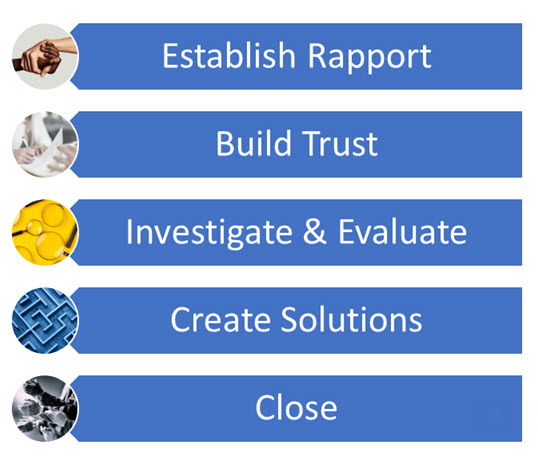By Mark Wright, OD, FCOVD,
and Carole Burns, OD, FCOVD

August 10, 2022
Do you have a consistent, effective system for selling products and services in your office? Here are steps to train both doctors and opticians to take to make it much more likely that patients purchase the products you prescribe and agree to the services you recommend.
Over the years we’ve found that owners/managers fall into one of two groups when it comes to systems: let the team do whatever they feel is best at the moment or dictate the presentation order with scripts. Between these two extremes are an infinite number of variations.

How do you know which way is better? The answer can be determined by measuring which way is more productive. Team members will have strong feelings about which way they believe is better, but the real question is which way is more productive.
For the approach where the presentation order and scripts are dictated by owners/managers, here are the five steps that have been shown to be most effective, especially when presented in this order:

Let’s go more deeply into each one of these steps.
Establish Rapport
The Cambridge Dictionary defines RAPPORT as “a good understanding of someone and an ability to communicate well with them.”i A team member helps patients know that they understand them by repeating back to the patient in their own words information. Here’s an example: “Mrs. Jones, I see from the form you filled out that you are here today because you are having trouble seeing when reading texts and e-mails on your phone. Are there any other problems you want us to address today?”
Build Trust
The Cambridge Dictionary defines TRUST as “to believe that someone is good and honest and will not harm you, or that something is safe and reliable.”ii Team members are building trust throughout the entire time they are in the office. Not being transparent on fees is often where trust is broken. The best approach is to use good communication to keep the patient aware of fees. The worst approach is to spring fees on patients at the end of the optical experience.
Other Articles to Explore
Investigate & Evaluate
A good thing to remember is that the case history never ends. The patient may feel that some data is not relevant when it really is. The best way to understand the patient, and what they need, is to make sure you explore the following categories of home, school, work and play. “Mr. Jones, help me understand how you use your eyes at home, school, work and play. Let’s start with home …”
Create Solutions
Once you understand how the patient in front of you uses their eyes at home, school, work and play, as well as any difficulties they experience in any of those arenas, then you can create solutions. Just like one pair of shoes is not the best solution for every activity in life, multiple pairs of glasses may be the best solution for the patient’s unique activities in life.
It is important to present this to the patient using the PROBLEM – SOLUTION approach. “Mr. Jones, you told me that you are having trouble working on your computer screen that is located directly in front of your eyes at work. There are special lenses that are now available that will make that task easier for you. Let me tell you about those lenses and how they will help you.”
Close
It is not enough to just educate patients. If you want patients to take an action, you have to ask for the sale. How you ask is very important. “You do not want single-vision contact lenses, do you?” is a perfect example of how not to ask for the sale.
Here is a short list of seven closing techniques every team member (including the doctors) should be comfortable using with patients:iii
Now or Never Closes
Summary Closes
Sharp Angle Closes
Question Closes
Assumptive Closes
Takeaway Closes
Soft Closes
Our favorite approach is the Assumptive Close. In the Assumptive Close, you assume the patient has already agreed to move forward with the purchase. A script for the assumptive close would be, “Mr. Jones, the doctor prescribed workspace lenses for you and you have already selected a great frame, how would you like to take care of that today?”
What is the advantage of dictating to the team the order of the presentation and the actual words to use? It gives you a baseline. If one staff member has an 80 percent conversion rate and another one only has a 30 percent conversion rate, you can go back and compare what the differences are.
Is it a presentation order issue or a wording issue? If the 30 percent person becomes a clone of the 80 percent person – does and says the exact same things in exactly the same order as the 80 percent conversion rate team member – does the conversion rate of the 30 percent person increase? This approach gives you a “best practices” approach to improve team performance.
References
i. RAPPORT | meaning in the Cambridge English Dictionary
ii. TRUST | meaning in the Cambridge English Dictionary
iii. How to Close a Sale: 7 Closing Techniques & Why They Work (hubspot.com)























